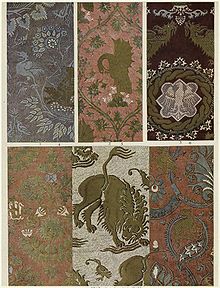Textile art of the Middle Ages

The Textile Art of the Middle Ages mainly comprises vestments , liturgical vestments , embroidered frontals , hunger towels and carpets. In Europe, the manufacture of such fabrics took place almost exclusively in women's monasteries. In addition to ecclesiastical, courtly and urban representation, they also served as mobile carriers of stories.
material
The materials used for tapestries , carpets and garments were canvas, wool or silk, embroidery threads were also made of silk and wool, as well as gold and silver threads, and occasionally pearls and precious stones.
Motifs
Animal motifs


Animal motifs were particularly popular in the 13th and 14th centuries. One of the main sources for the symbolic representation of animals in a sacred context was the Physiologus , which was mainly used in Latin translations in numerous manuscripts and text versions. In the courts and in the social elite, patterned silks, the images of which were combined into lively scenes, were status symbols of the social elite. The precious materials and the elaborate weaving process made textiles coveted luxury goods.
Pelican and panther
In the special exhibition of the Abegg Foundation in 2016 there is a church robe that was probably made in the second half of the 14th century. On the garment there is a motif of a pelican and a panther facing each other. The pelican feeds its young with meat from its own breast. The representation is based on the Physiologus, a theory of nature written in the second century AD. This describes how the pelican sacrifices itself for its young. Interpreted from a Christian perspective, this makes him a symbol of selfless devotion. The panther is described in the Physiologus as a gentle, peaceful animal that all other animals follow. Thus both animals are considered symbols for Christ.
Heraldic animals
Animal motifs can often be found on coats of arms. Lions, eagles and cranes were widespread, the characteristics attributed to them underpinning the incontestable rule of certain noble families. In jousting tournaments, the participants of which could not be recognized by the armor, the heraldic animals stood in for the fighting person. Many fabrics showed repeating patterns from coats of arms, banners and heraldic animals and functioned as status symbols and means of public communication.
Hunting motifs
Depictions of animals hunting one another or hunted down by hunters were widespread. The motifs, which also include jumping dogs and horns hanging from branches, often form small narratives in their entirety. They reflected the medieval big game hunting, which was a right of rule. It was much more a privileged pastime than a means of getting food.
literature
- Lisa Monnas: Merchants, Princes and Painters. Silk Fabrics in Italian and Northern Paintings, 1300-1550 . New Haven: Yale University Press 2008. ISBN 978-0300-11117-0
- Evelin Wetter: Medieval Textiles III. Embroidery up to around 1500 and figuratively woven borders . Riggisberg: Self-published 2012. (Textile collection of the Abegg Foundation. 6.) ISBN 978-3-905014-50-1

